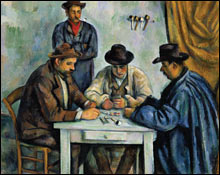
Cézannes's The Cardplayers |
WILLIAMSTOWN — If cows ever swished their tails in Central Park while discussing the latest acquisitions of the Metropolitan Museum of Art, they’ve since moved on to greener pastures. Not so the Holsteins at the Sterling and Francine Clark Institute of Art, who these days are surely locking horns over what’s up on the other side of the parking lot. Belying its placid title, “The Clark Brothers Collect: Impressionist and Early Modern Paintings” is the record of a collecting war between early-20th-century heirs to the Singer Sewing Machine fortune, a war whose energy, even half a century after the brothers’ deaths, all but obliterates the show’s eye-popping art, Manets and Renoirs and Monets and Van Goghs and Cézannes, Sargents and Hoppers and Matisses and Picassos to equal what the MFA is currently presenting in “Americans in Paris 1860–1900,” works you wouldn’t expect to see outside a major museum.The Clark, of course, is a major museum, its bucolic setting notwithstanding. Opened in 1955, it houses the personal collection of Robert Sterling Clark and his French wife, Francine, a collection whose older highlights include a possible Piero della Francesca (Virgin and Child Enthroned with Four Angels) and a possible Rembrandt (Man Reading). For “The Clark Brothers Collect,” many of Sterling’s late-19th- and early-20th-century masterpieces are hung alongside similar works that his younger brother Stephen donated to the Met and to Yale University. (The show will be on view at the Met from May 22 through August 10 of 2007.) You’re invited to join the cows in discussing who had the better taste, and the better collection.
The story begins in the mid 19th century, when Sterling and Stephen’s lawyer grandfather, Edward Clark, became a partner in Isaac Merritt Singer’s sewing-machine company; the estate he left his son Alfred upon his death in 1882 amounted to some $50 million, not including the blocks of West Side Manhattan real estate that he bequeathed to his four grandsons, who grew up at the family estate in Cooperstown. Sterling (1877–1956) graduated from the civil-engineering program at the Sheffield Scientific Institute at Yale and joined the Army, which sent him to the Philippines and then to China, where he fought in the Boxer Rebellion. After a year in Washington, where the press dubbed him “the richest man in the Army,” he was back in China on an expedition to map the provinces west of Beijing. Stephen (1882–1960) graduated from Yale University and entered Harvard Law School, then transferred to Columbia to be near his ailing mother. He served a term in the New York State Assembly, as a Republican; in 1909 he married Susan Vanderpoel Hun, the youngest daughter of an Albany family who summered in Cooperstown, and they set about finding a house on the Upper East Side and building one in Cooperstown.

Sterling, meanwhile, had gone to Paris to prepare for a mapping expedition in Egypt, but his life changed course when he met Comédie-Française actress Francine Modzelewska, the illegitimate daughter of a Parisian dressmaker with an illegitimate daughter of her own; Sterling and Francine themselves didn’t marry till 1919. The Great Bust-Up of 1923 is anticipated in letters they wrote a dozen years earlier. Sterling to a Clark Estates agent: “Cooperstown does not interest me in the slightest and were I alone in all this I would sell out of every stick I had in the place.” Stephen, who was left to run the family business, to Sterling: “I have to keep up all the old family traditions and I have to pay all the old servants.”
Sterling was a soldier, adventurer, and man of the world with a glamorous French actress wife, a house near the Arc du Triomphe, and a “fierce and fiery charger” that he rode in the Bois du Boulogne; moreover he was the elder brother. Stephen was a lawyer and businessman who had married a respectable American girl and stayed home to direct the Singer Company and deal with the family’s Cooperstown responsibilities; he may have felt like the elder brother. The two came to blows in 1923 when Sterling proposed to change the terms of Singer trusts (created before he married) that excluded Francine and her daughter. The other brothers refused; Sterling tried to break the trusts and failed. He and Stephen never spoke to each other again.